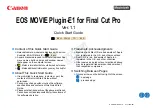
Windows Installer Editor Reference
127
Assembling an Installation
Delete (lower left)
Remove a directory from the installation. This does not delete it from the
destination computer.
Details (lower left)
On the Files page, use this to set NTSF permissions.
On the Web Files page, use this to set all IIS-related details about the item, as
well as Web-based security.
Wildcards
Update settings of a directory in the installation.
See
Editing Settings for Automatic Updating
on page 140.
Operation
Add operations to the installation. See:
Removing a File From the Destination Computer
on page 142
Copying and Moving Files on the Destination Computer
on page 143
Delete (lower right)
Remove a file or operation from the installation.
Details (lower right)
View details on the installation’s files or operations, including attributes, name
and source, permissions, self-registration, and assembly options. See:
Editing File Details
on page 145.
Removing a File From the Destination Computer
on page 142.
Copying and Moving Files on the Destination Computer
on page 143
To learn about the Web-specific functionality of the Web Files page, see
About Web
Installations
on page 266.
See also:
Installation Directories
on page 128
Files or Web Files Page Icons
on page 129
Adding Merge Modules Instead of Files
on page 132
Adding Files From the Wise Software Repository
on page 133
Adding .NET Assemblies to the Installation
on page 137
How Self-Registration Information is Captured
on page 155
When to Use the File-Related Installation Expert Pages
You can add files to an installation on the Files page and the Web Files page. If you are
using Visual Studio integrated editor, you also can add files on the Visual Studio Solution
page. The following table describes when you should use each of these pages.
Page
When to use it
Files
z
To add files to any installation
z
In an installation that is part of a Visual Studio
solution, to add files that are not included in the
solution
See
Files or Web Files Page
on page 125.
















































